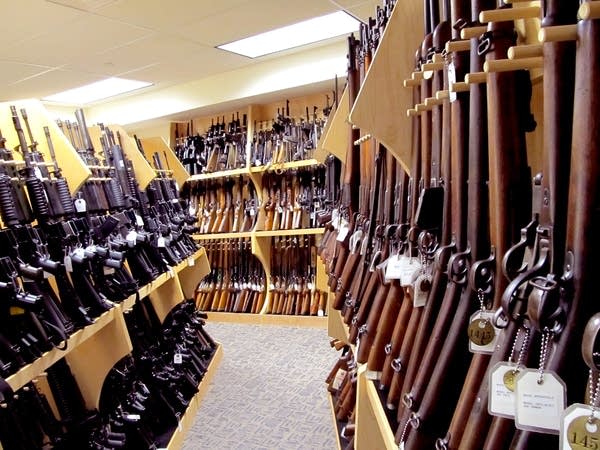A look at the ATF Tracing Center's gun library
Go Deeper.
Create an account or log in to save stories.
Like this?
Thanks for liking this story! We have added it to a list of your favorite stories.

The federal Bureau of Alcohol, Tobacco, Firearms and Explosives received 340,000 requests from local law enforcement last year to trace guns used in crimes.
The center averages about 1,000 law enforcement requests per day, said Charles Houser, chief of the Tracing Center.
Contrary to popular belief, there is no computerized database the ATF can search to find a gun owner. The ATF uses 20th century technology -- the telephone -- to first call the company that made the firearm.
"We have to have them look into their records and tell us what they did with it," Houser said. "And we follow the chain of distribution of the firearm all the way until we find a retail purchase."
Turn Up Your Support
MPR News helps you turn down the noise and build shared understanding. Turn up your support for this public resource and keep trusted journalism accessible to all.
That's where the ATF stops the trace. After the bureau finds the first buyer, he said, it's up to local police to connect the rest of the dots to a crime scene.
The tracing center successfully completes 70 percent of its trace requests, Houser said. But there are several reasons why a gun trace is unsuccessful. Sometimes the gun is old and doesn't have a serial number. Before the federal Gun Control Act of 1968, manufacturers were not required to give each gun an individual serial number.
Houser said the most common reason a trace is unsuccessful is because the law enforcement agency gives an inaccurate description of the make and model of the gun. Sometimes, the reporting agency can't tell what kind of gun it is. To aid in identification, the tracing center keeps a library of more than 12,000 firearms.
The tracing center keeps as many different makes and models of guns as needed for reference purposes, said John Spencer, chief of the Firearms Technology Branch for ATF. He oversees the tracing center's firearm library, a collection that contains everything from homemade, single shot devices crafted from flashlights and belt buckles, to anti-tank and anti-aircraft guns used in wars around the world.
"This not a museum -- by no means -- this is an actual working collection," Spencer said.
He said sometimes ATF personnel are called on by local law enforcement to help identify a weapon an officer hasn't seen before.
"We get calls from say, a state trooper on the side of the road who says, 'Hey, I've got this interesting firearm, I don't know what it is.' " Spencer said. "Lot of times they can take a quick picture. They can actually email it to us and we ... can come in here and have an item out of the collection to compare it to."
Many of the weapons in the library have been taken off the streets by local officers. Some are military weapons in here -- including a gold-plated AK-47 with an Arabic inscription indicating that it is a "gift from Saddam Hussein." The ATF calls those "bring backs" -- *mementos* brought to the United States *by* soldiers who fought in foreign wars.
In a third of trace requests, the chain of distribution leads to a gun store or pawn shop that's gone out of business, Houser said. Under federal law, a licensed firearms dealer that goes out of business has to send paper records to the tracing center.
Many gun stores don't stay in business long, because the Tracing Center receives an average of 1.2 million paper records every month.
The records, each of which must be scanned into an ATF computer, come to the tracing center in brown boxes that are stacked along a wall. It takes a staff of 100 people working two shifts five days a week -- from 6 a.m. to midnight -- to keep up.
Houser said there have been times when the tracing center didn't have enough room to hold the boxes. So they've rented shipping containers the size of box cars and put them in the parking lot for temporary storage.






